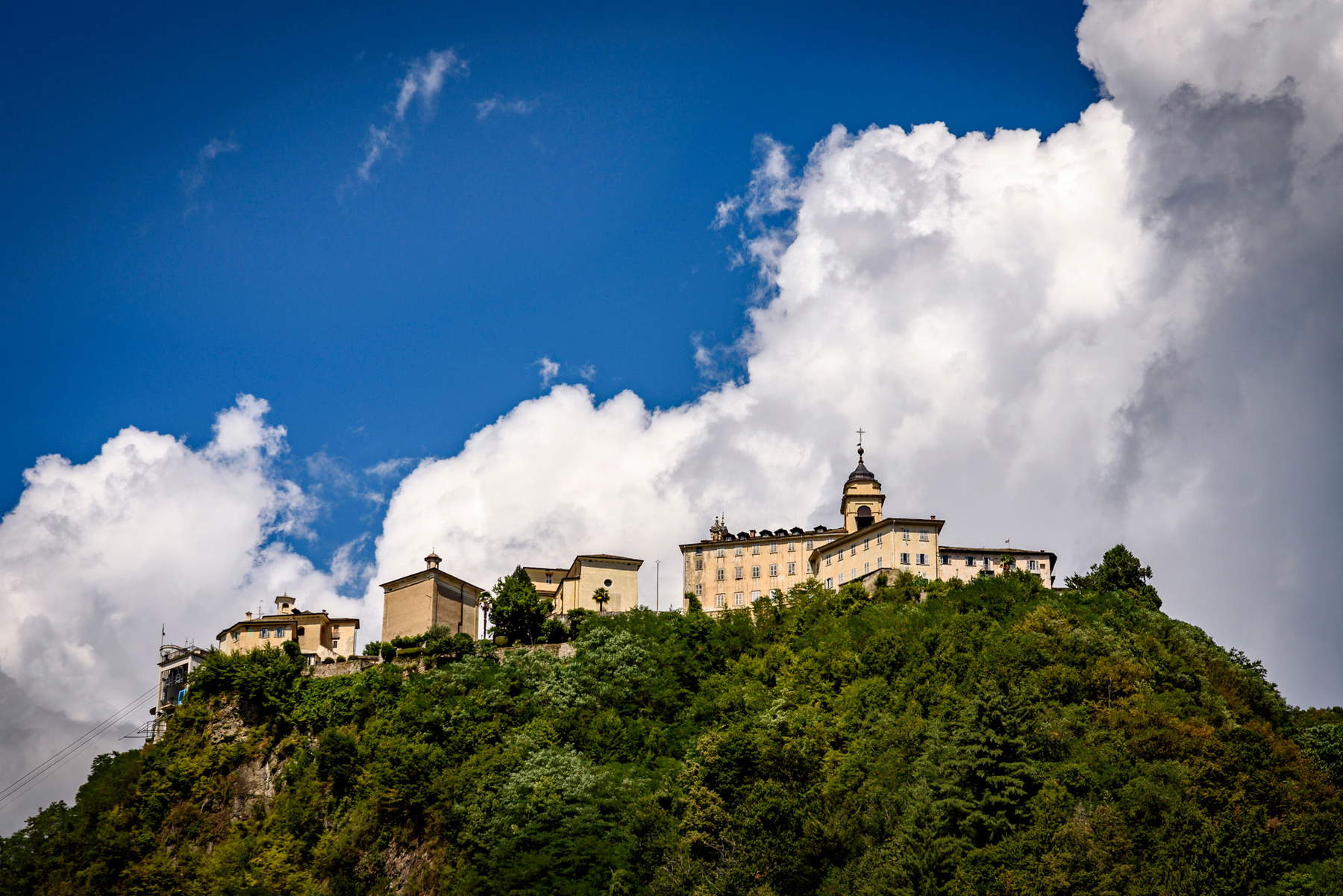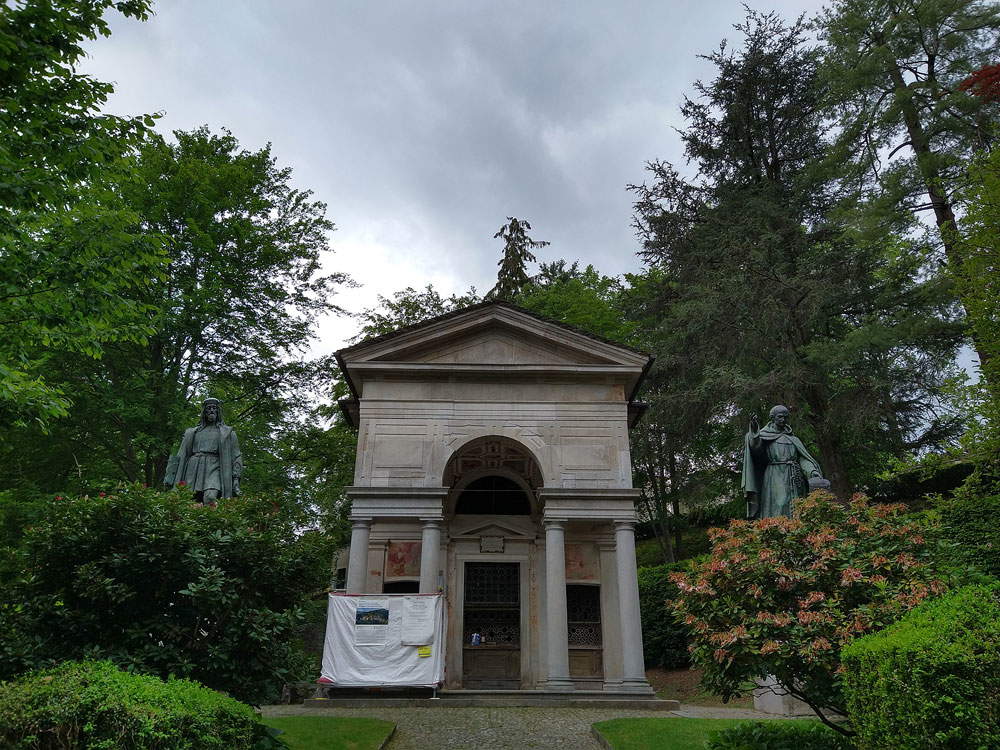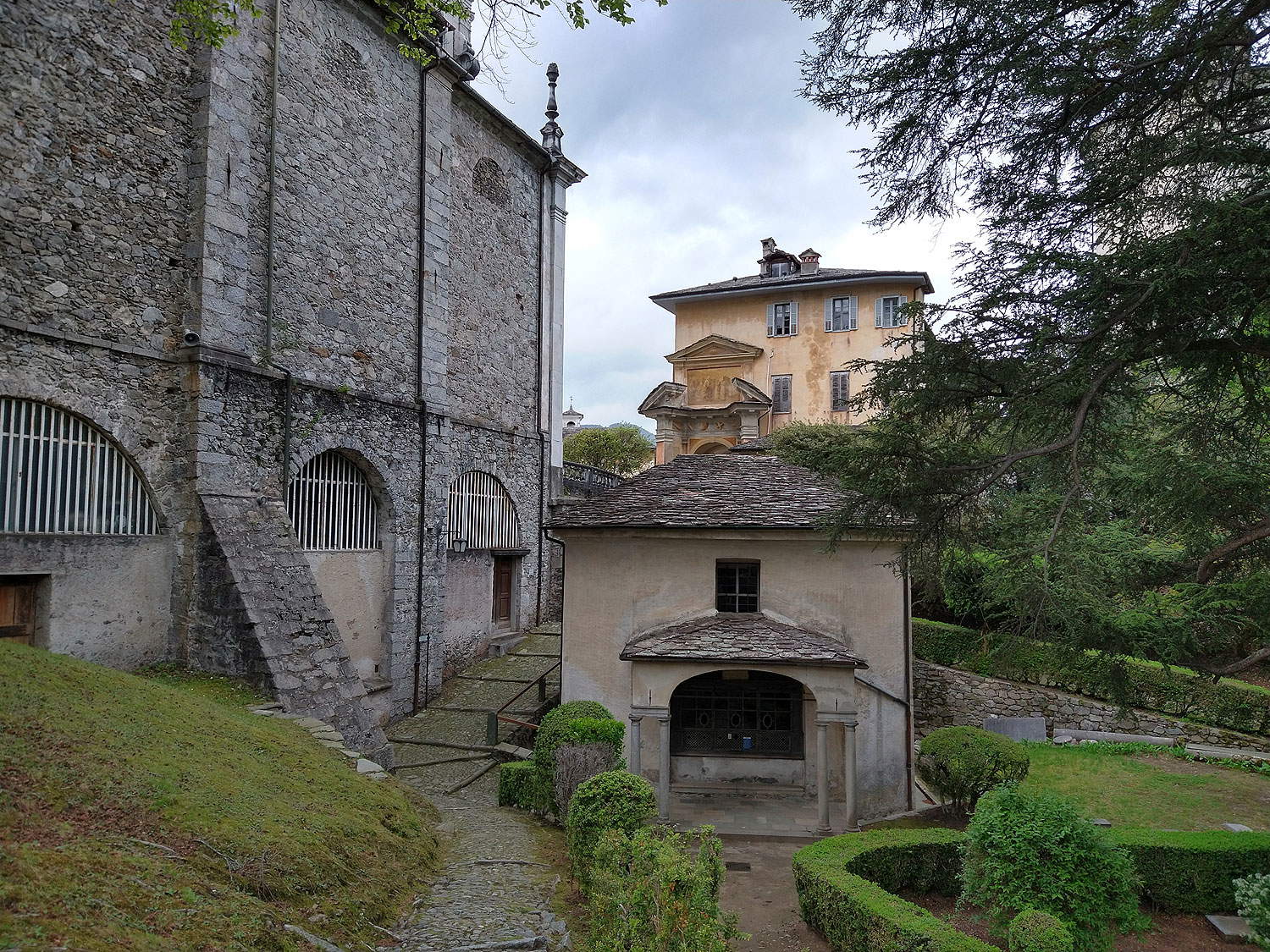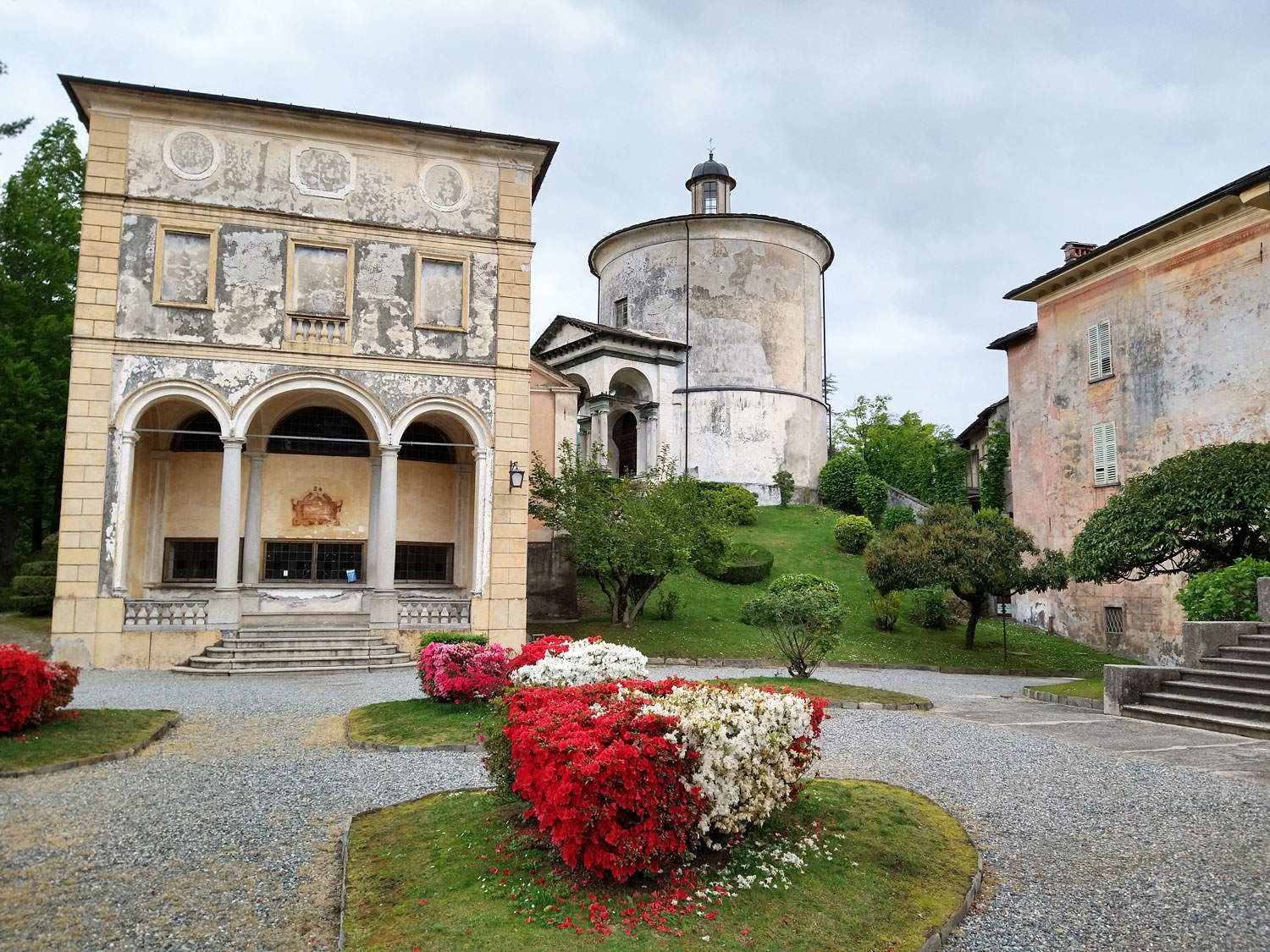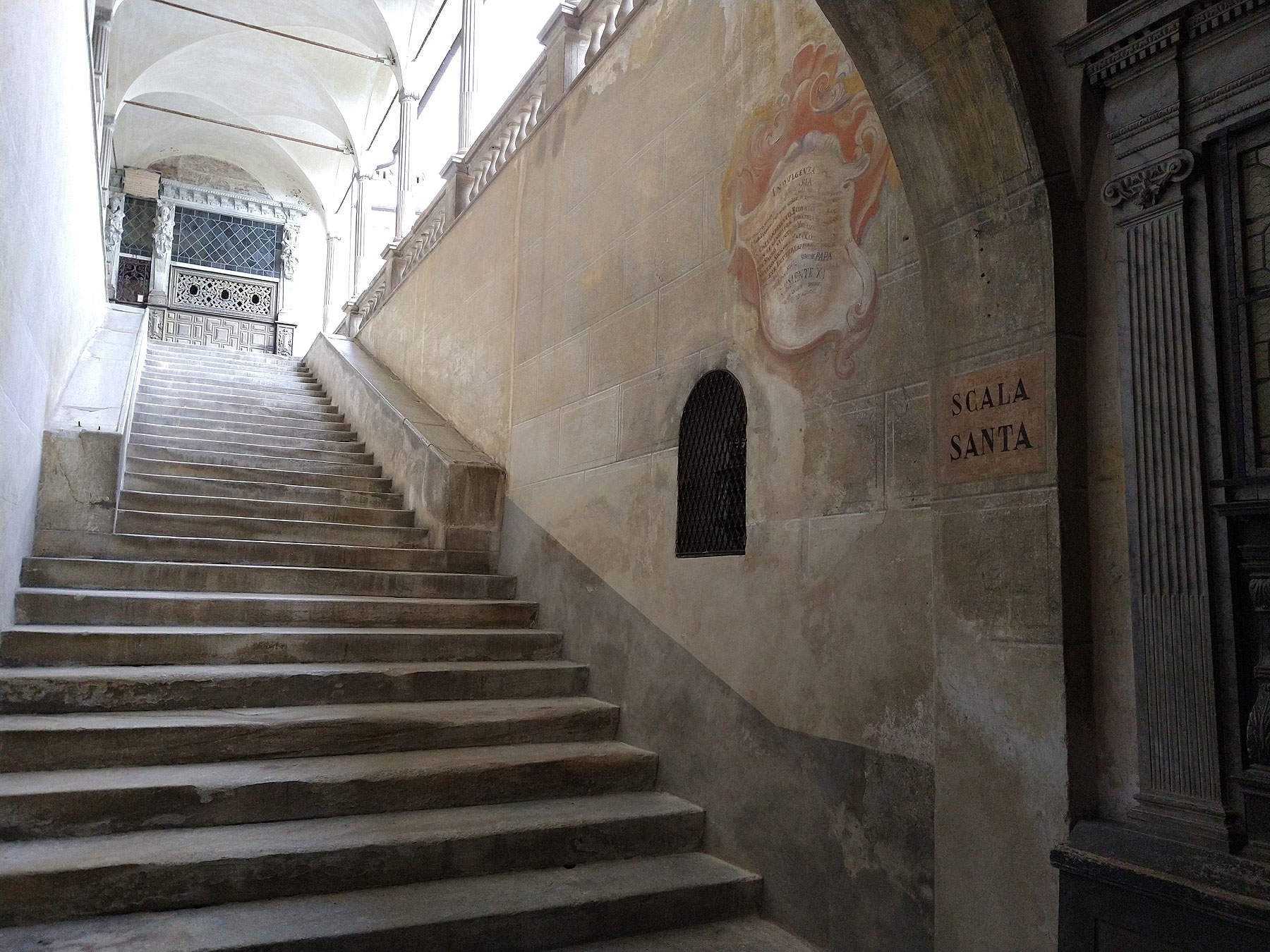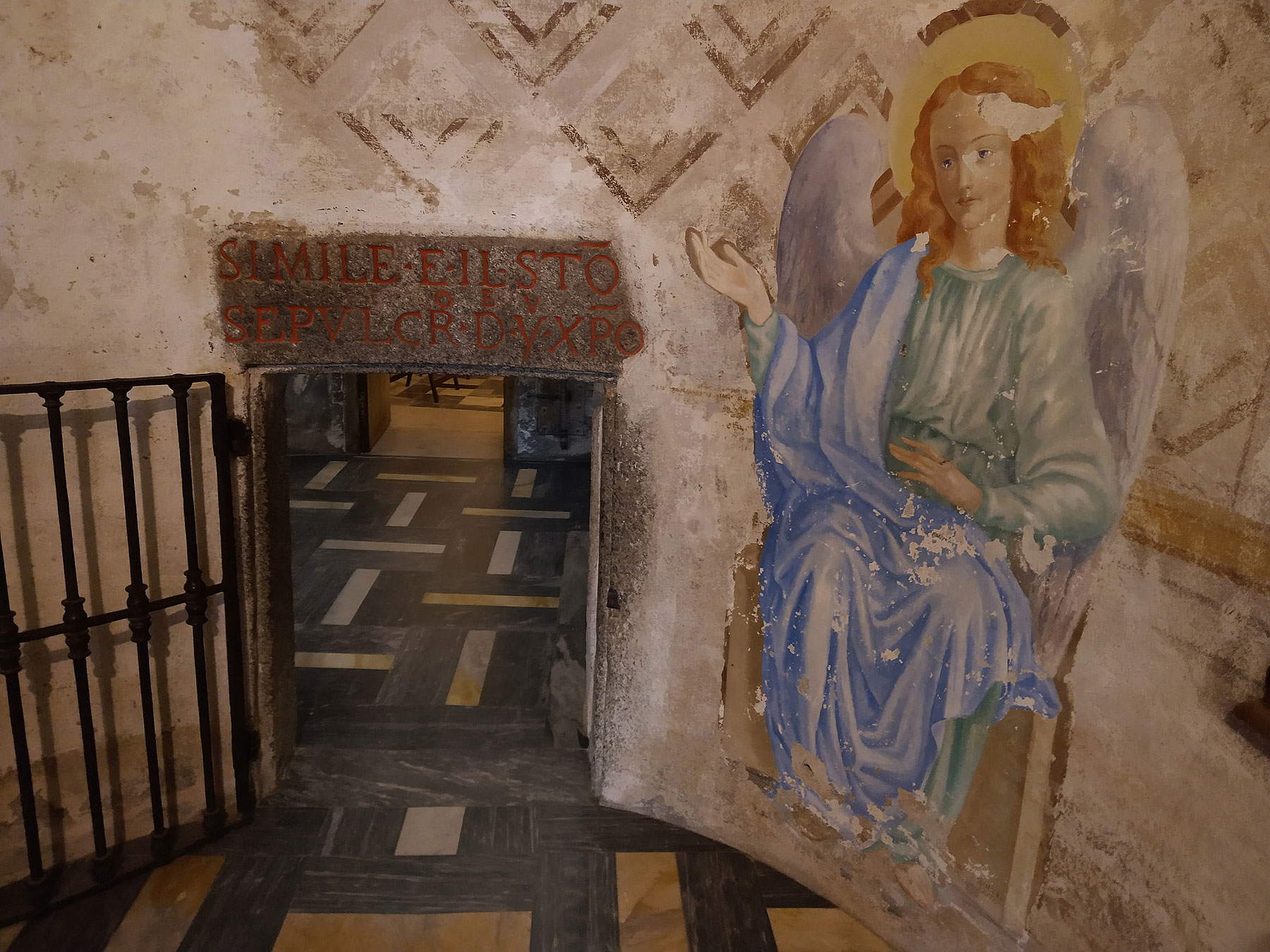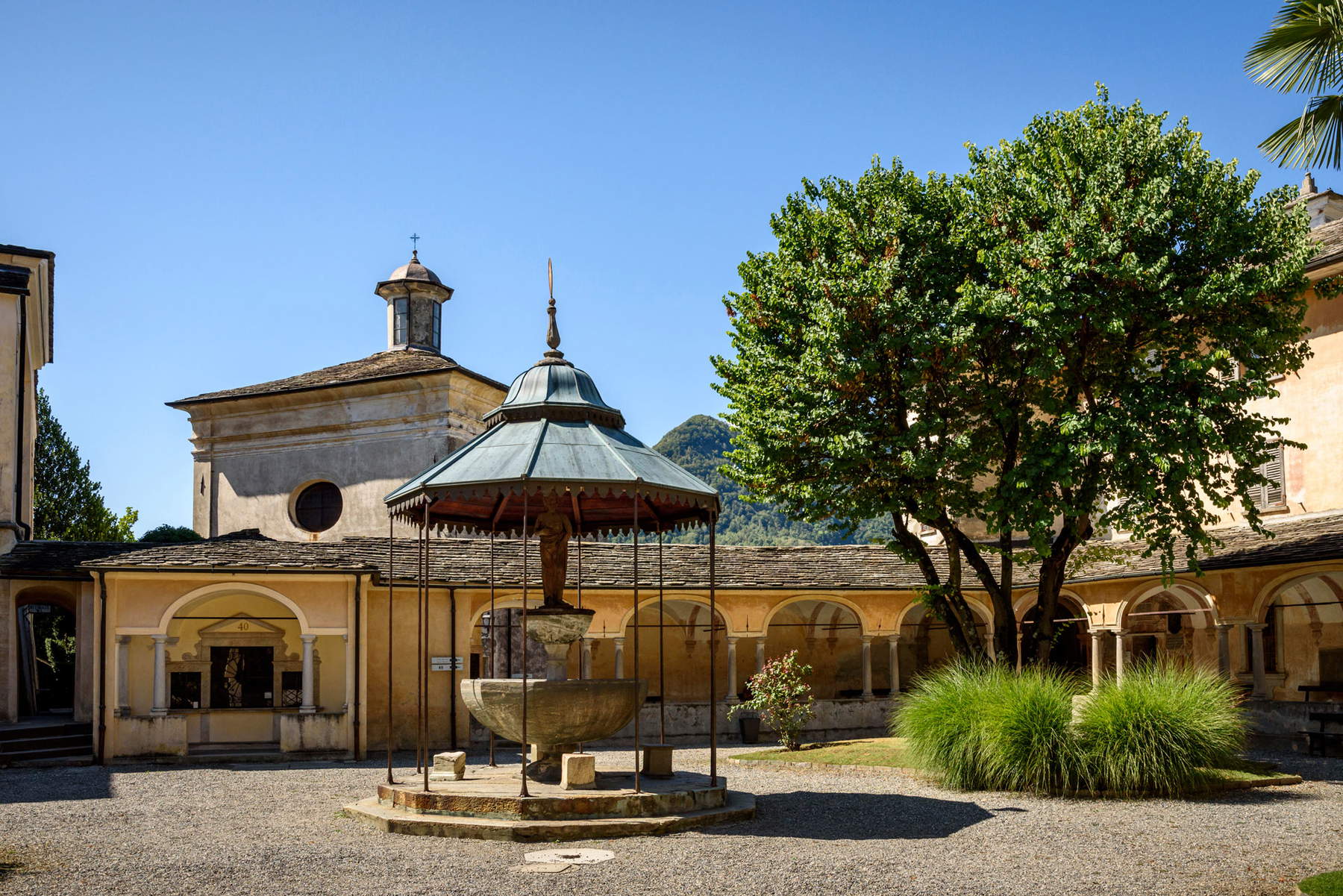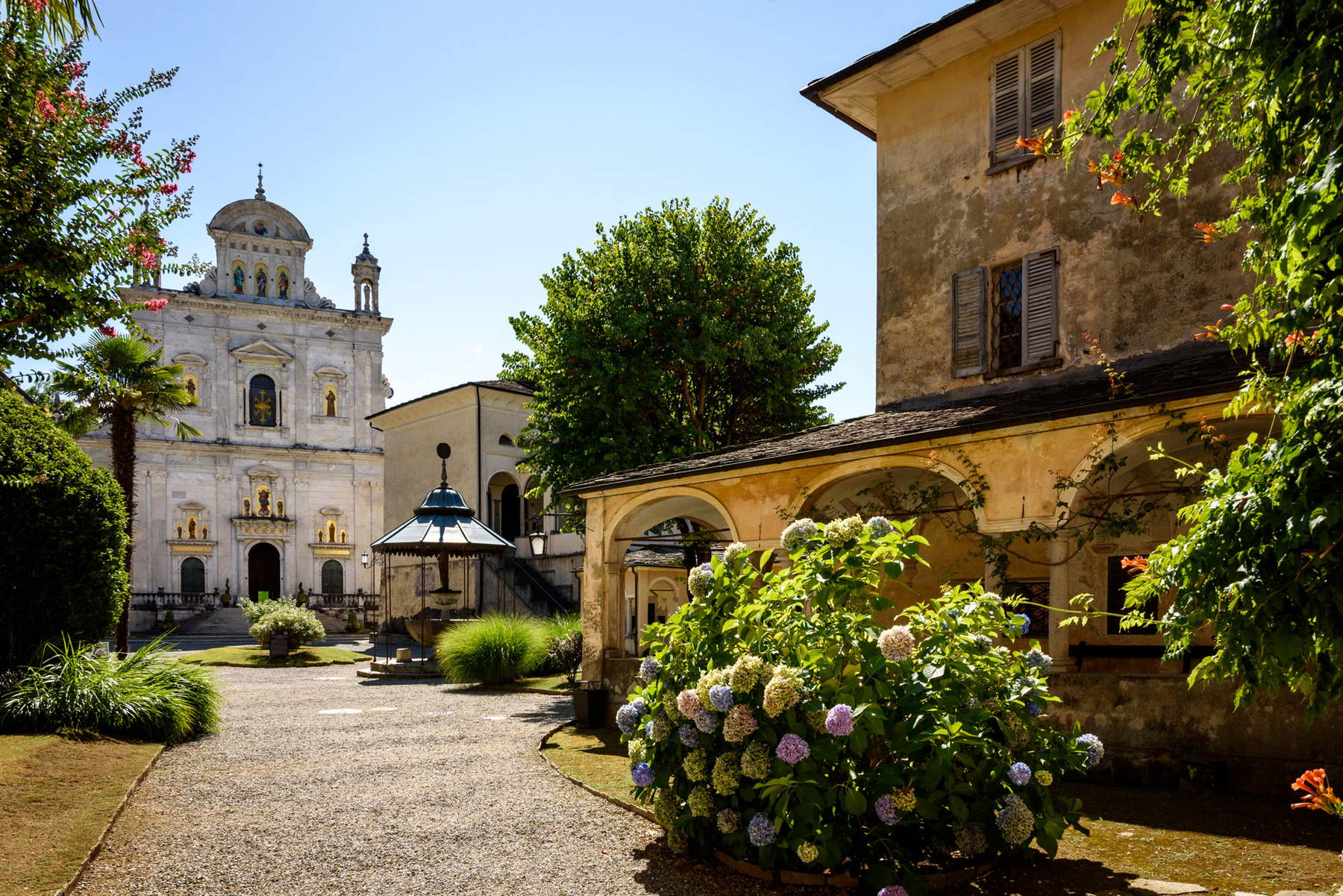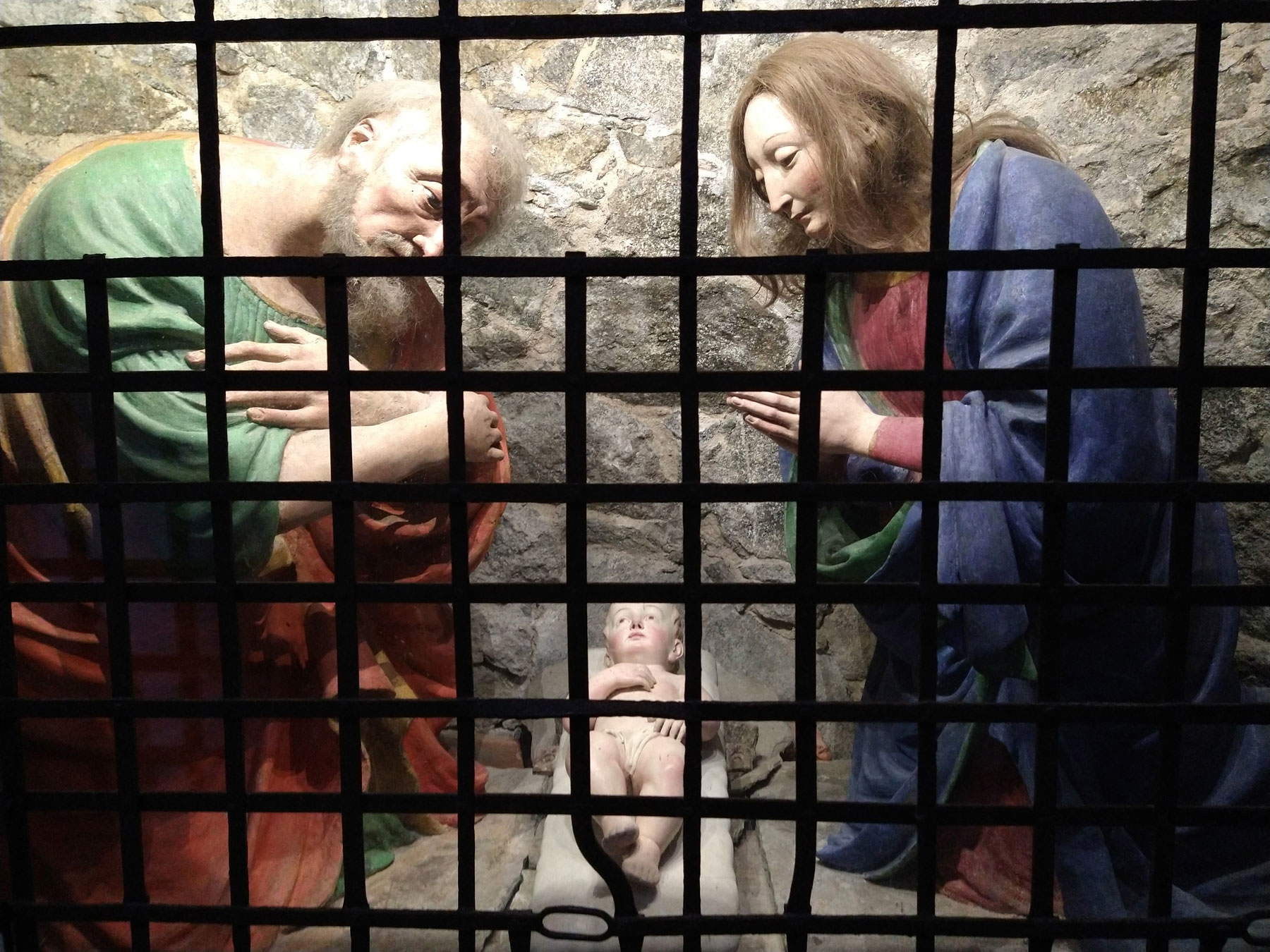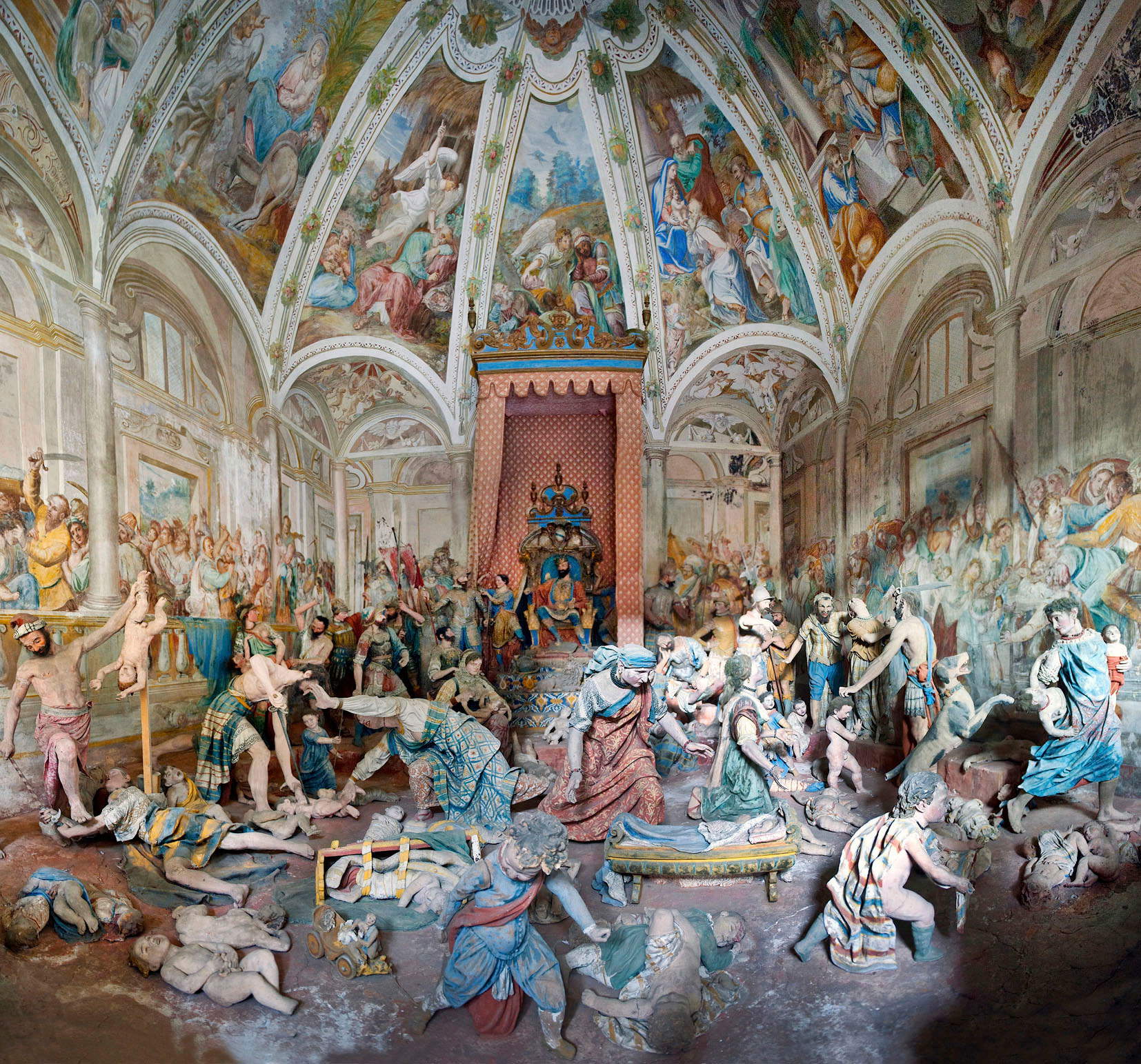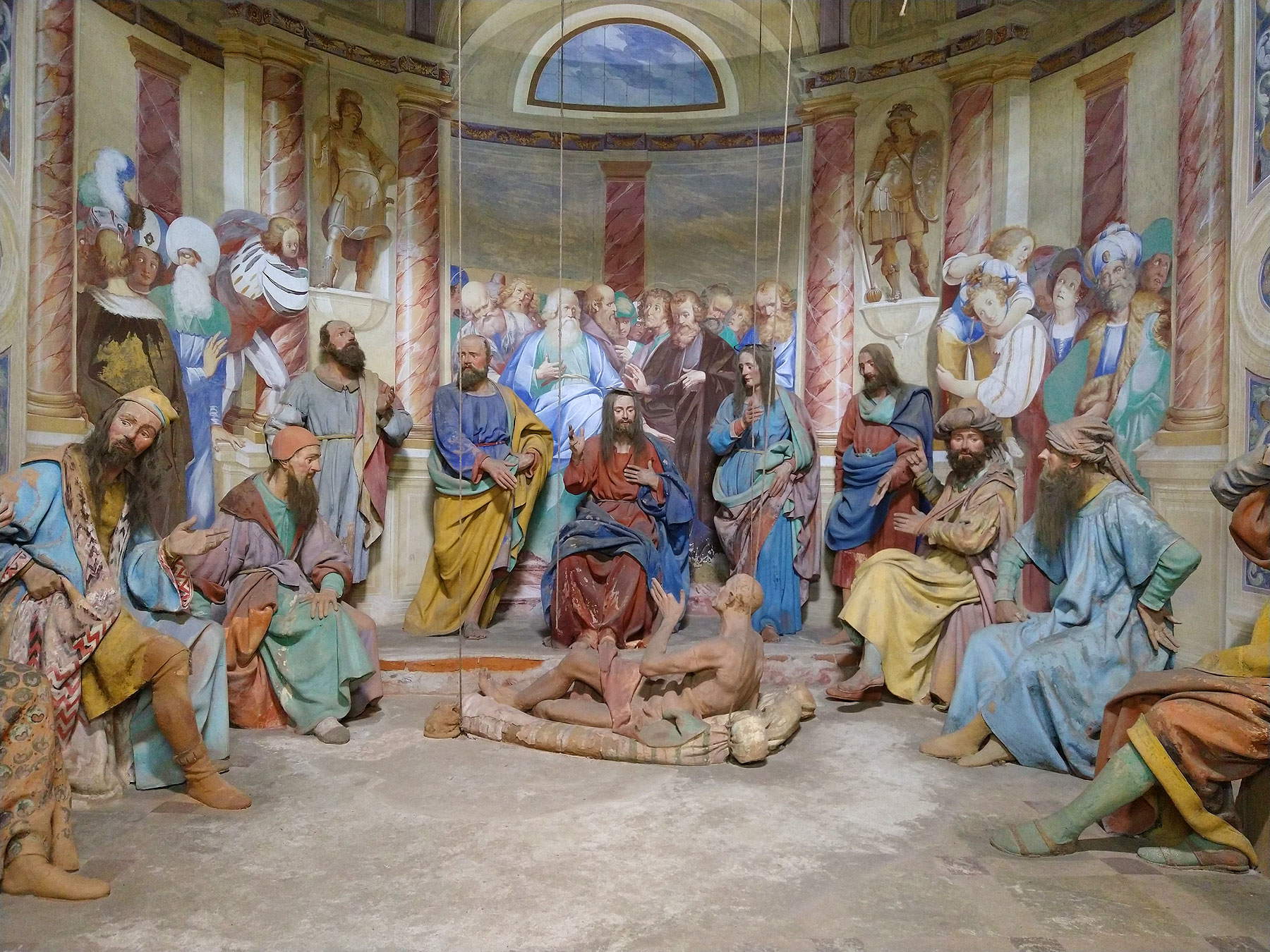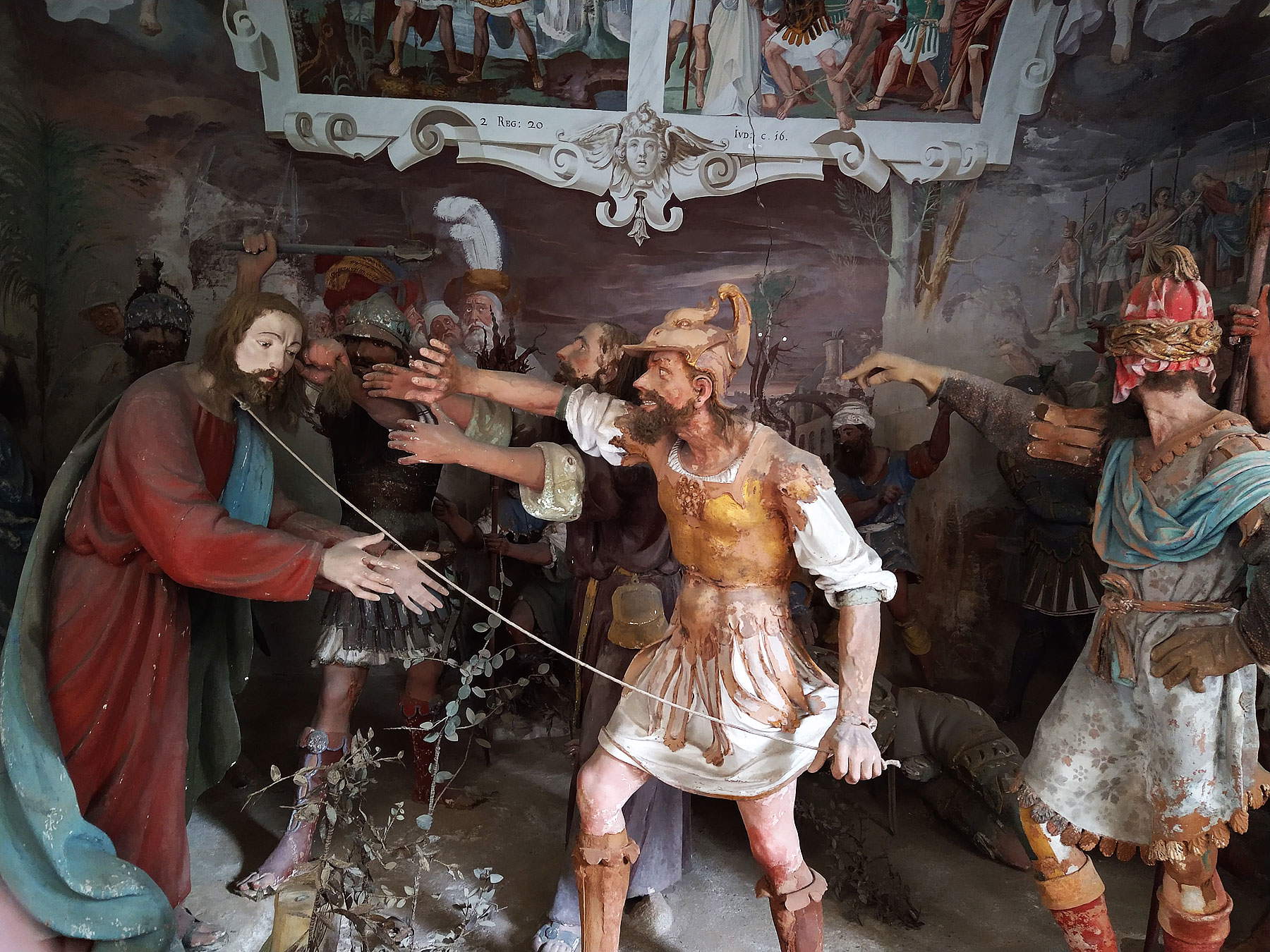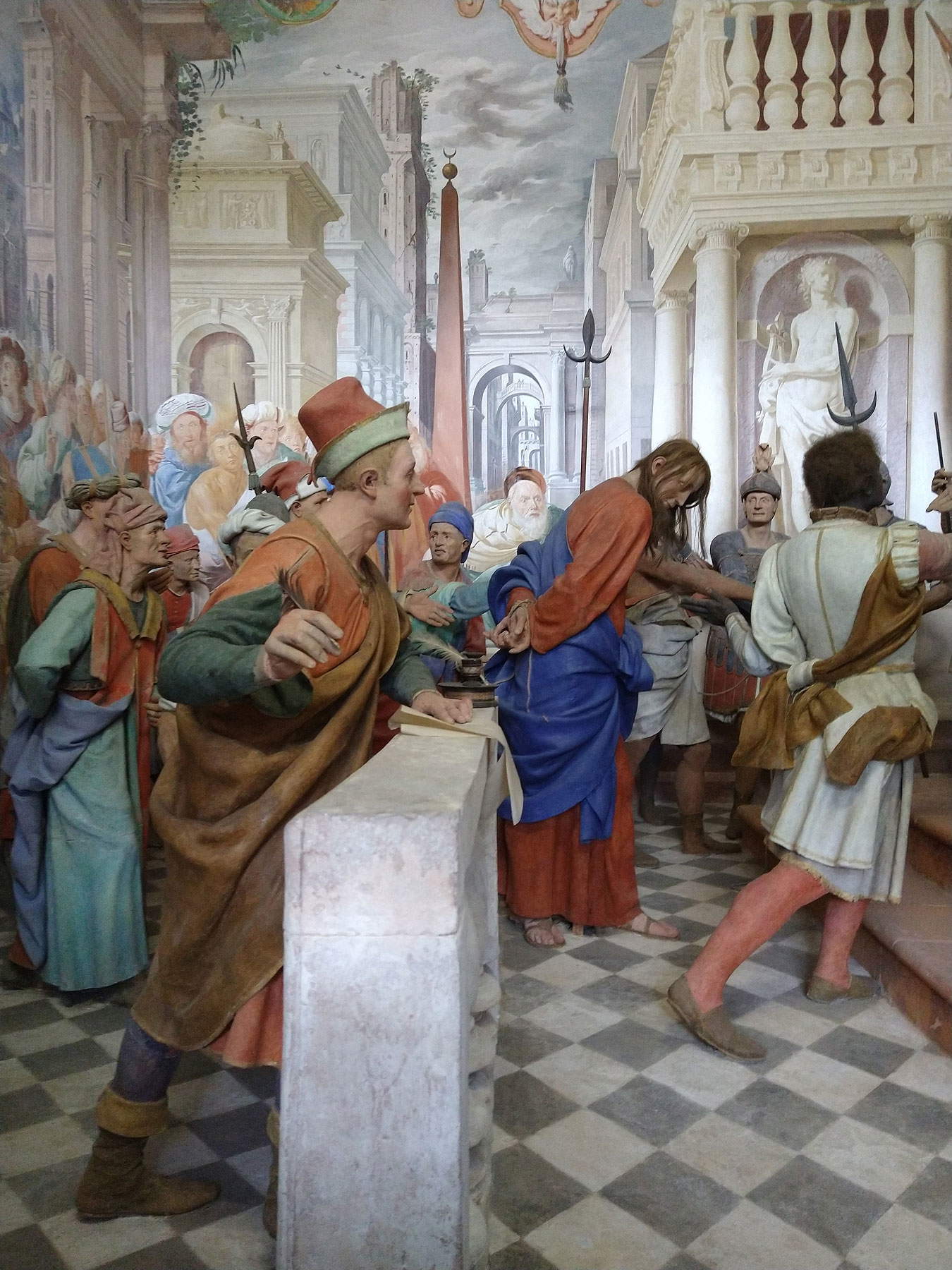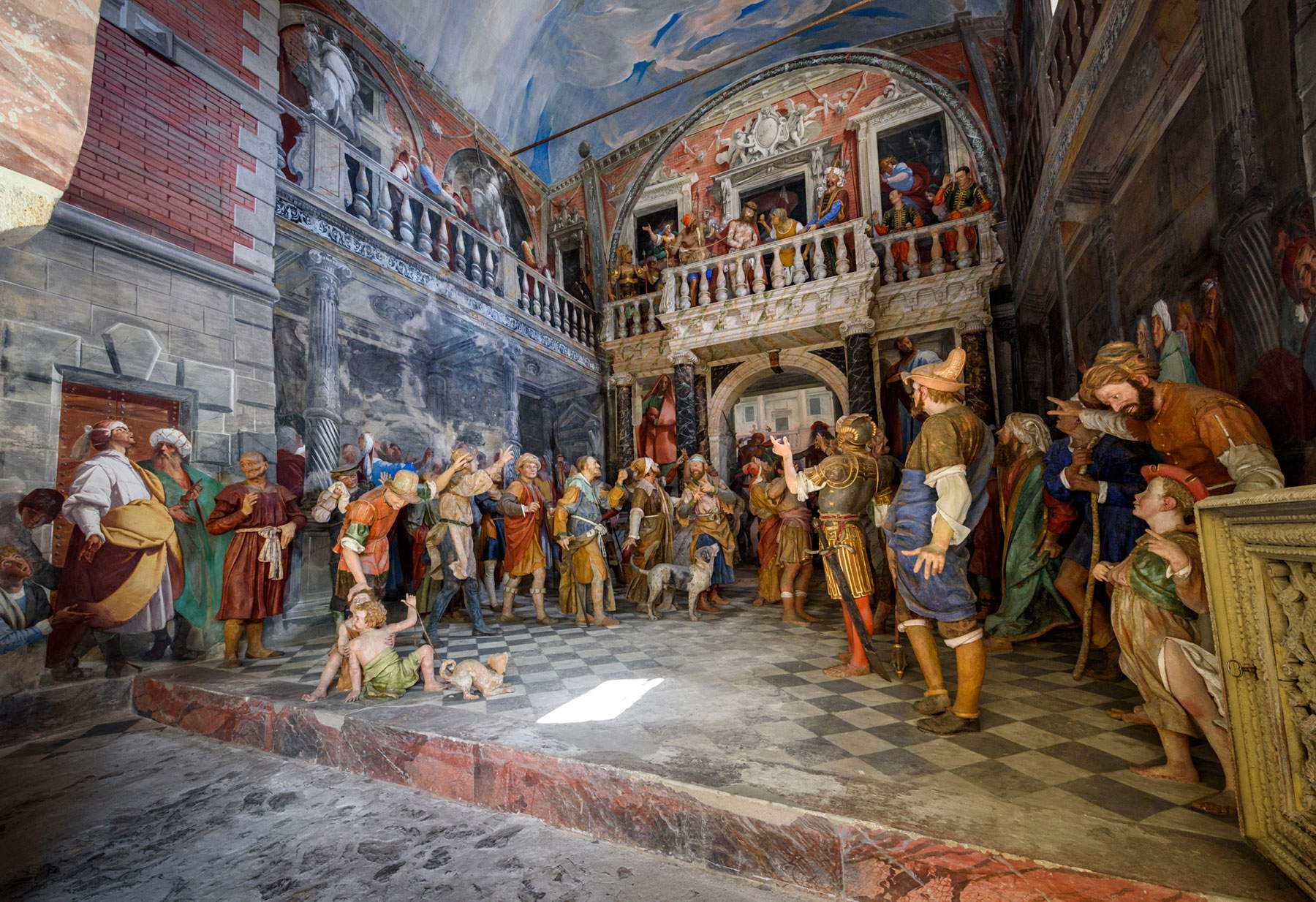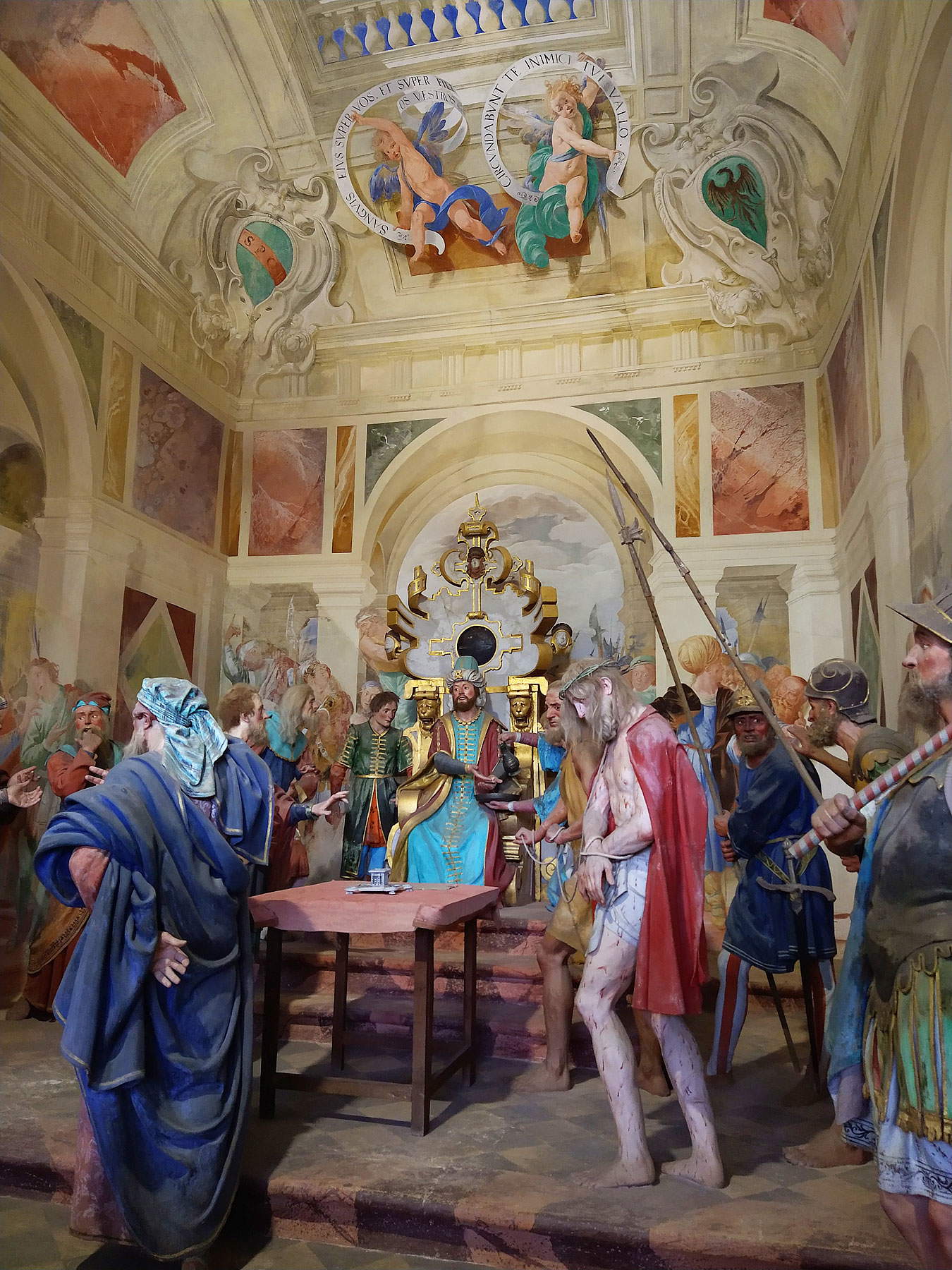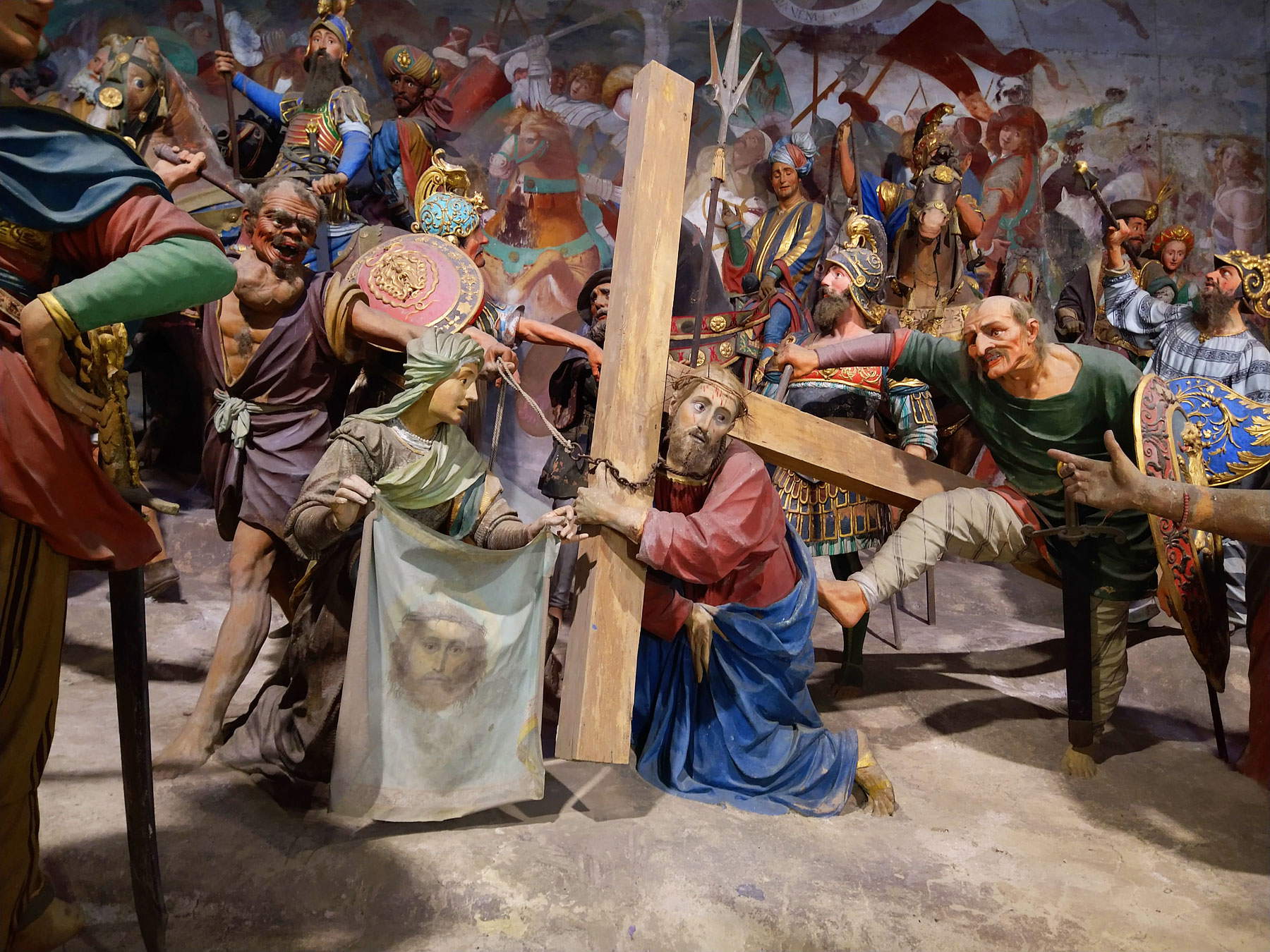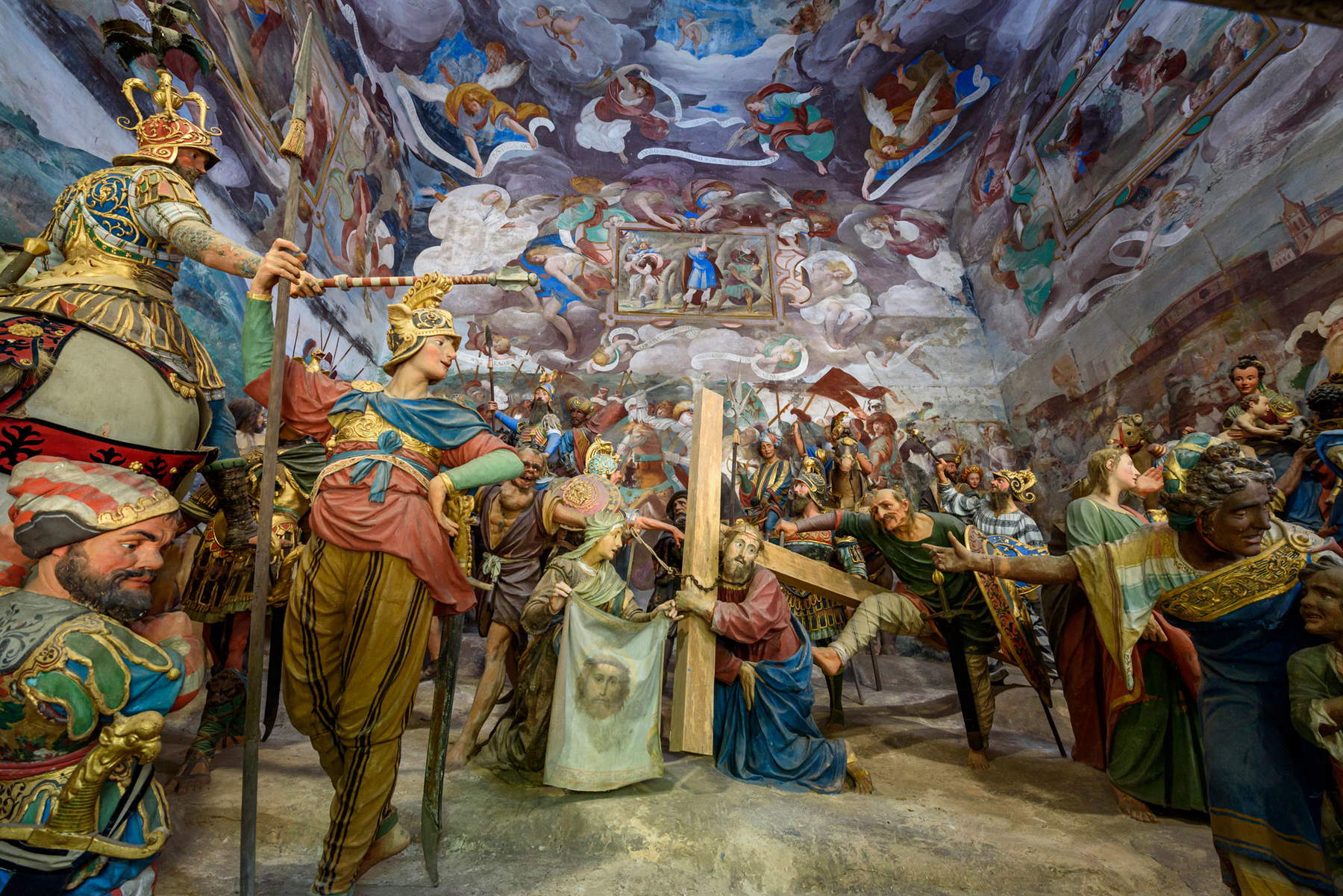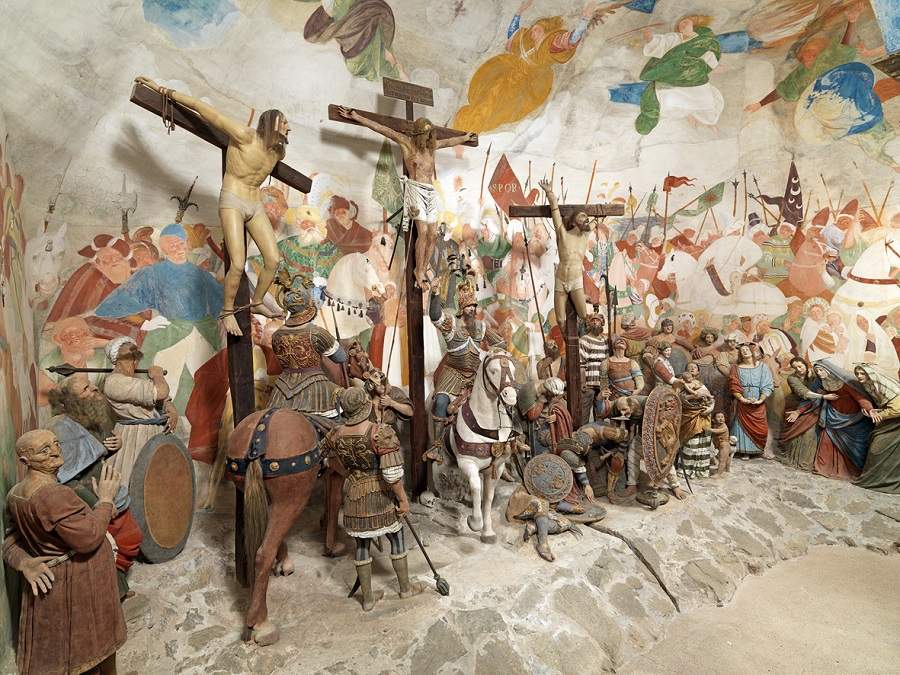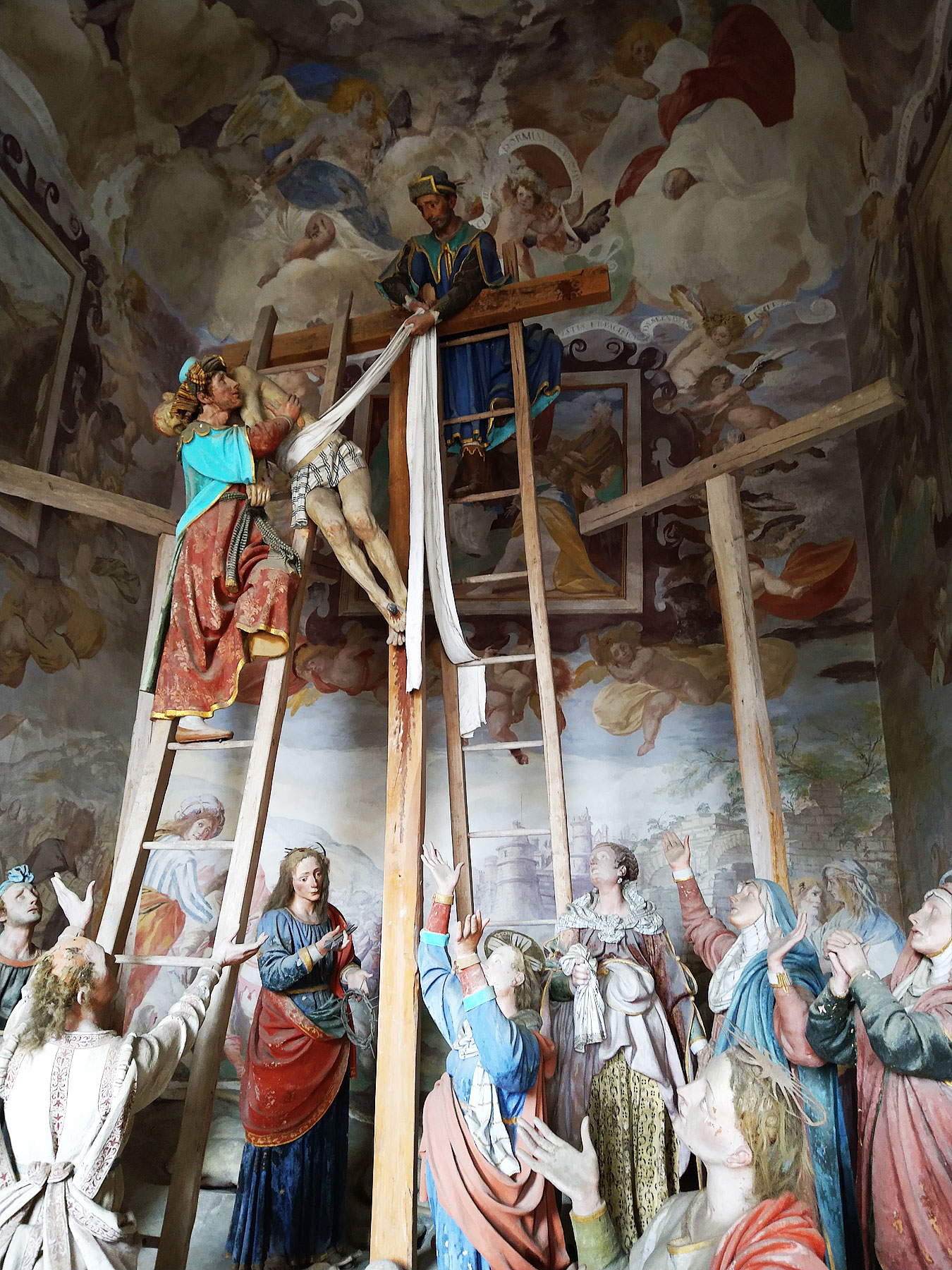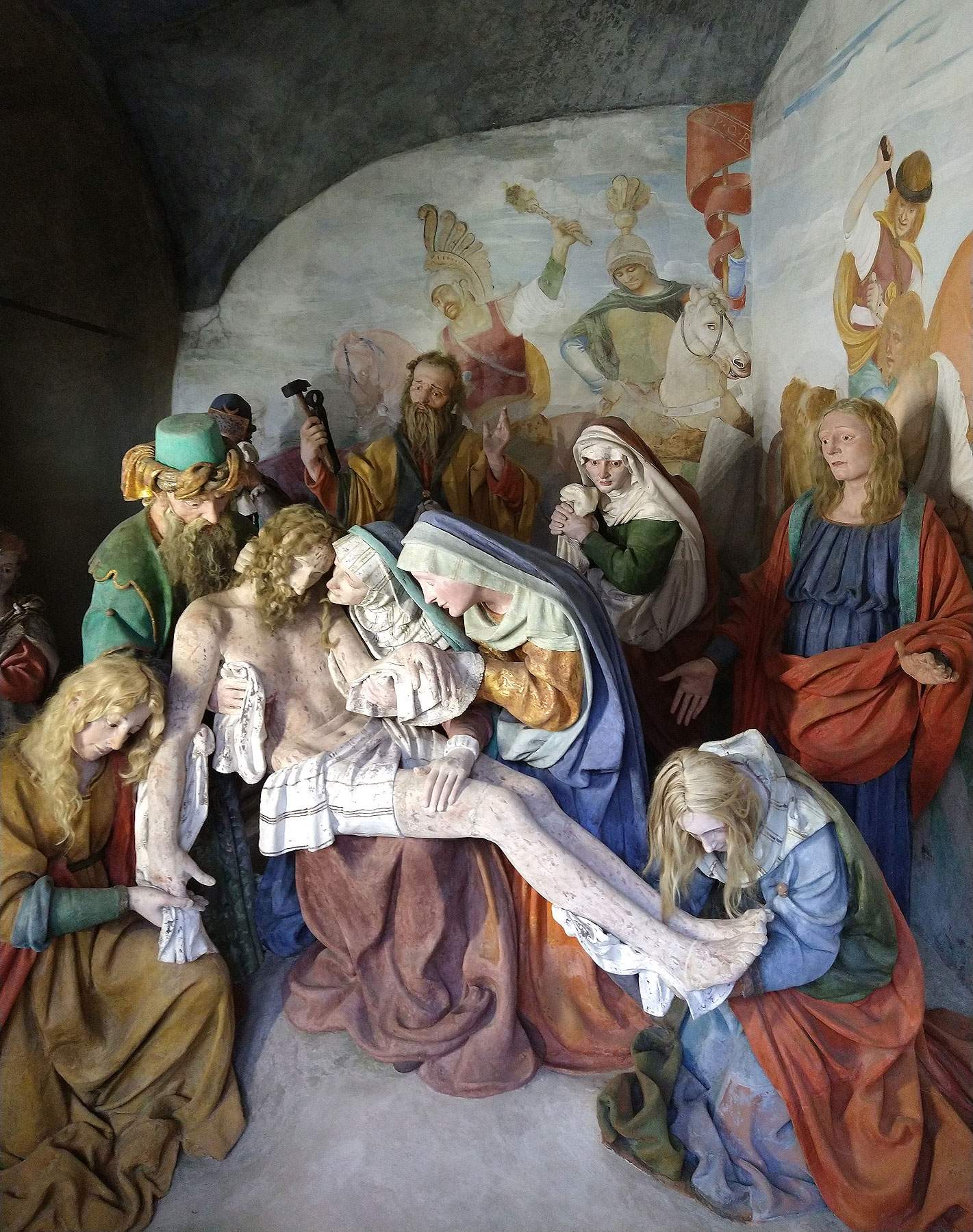by Federico Giannini, Ilaria Baratta , published on 03/09/2021
Categories: Works and artists
/ Disclaimer
Created as an "alternative" to the pilgrimage to the Holy Land, the Sacred Mount of Varallo, founded in the late 15th century, is a path of 44 chapels that recreate the life of Jesus in an exciting and engaging way. Many great artists worked there.
The Sacred Mount of Varallo, wrote the great art historian Giovanni Testori, is “one of the most unexpected, greatest and exceptional monuments that art in northern Italy has built, in clear, thoughtful and solemn response to what were the divine theorems and divine poetics of the ’golden men’ of the Italian Renaissance.” According to Testori, this extraordinary place represents the fullest, freest, “enfranchised and mighty response that resounded from the Po upwards in the first decades of the sixteenth century, not only because of its sense, which was totally popular and plebeian in relation to an art aimed, instead, at the absolute princely, aristocratic and courtier, but also because of the unprecedented invention (and mixture) of the means by which it was realized.”
Clinging to a hill overlooking the town of Varallo, in the heart of Valsesia, the Sacro Monte of Varallo, which appears from afar as a kind of citadel, is the oldest (as well as the best known and most artistically interesting) of the nine sacred mountains that rise in the Piedmont and Lombardy Alps and that now make up the site, UNESCO World Heritage Site, of the “Sacred Mountains of Piedmont and Lombardy” (the other eight are those of Belmonte, Crea, Domodossola, Ghiffa, Oropa, Orta, Ossuccio and Varese): is a monumental complex consisting of forty-four chapels and a basilica that were initially intended to reproduce the most significant places in Jerusalem in order to offer a viable alternative to the faithful unable to make the pilgrimage to the Holy Land, although later, as the centuries passed, the project changed shape to become a kind of grand gospel narrative, in order to allow the Christian to retrace the entire life of Christ through a scenic complex that blends all the arts (architecture, painting, and sculpture) and represents one of the most interesting examples of art born for the people in the entire history of 16th-century art.
For Testori, to whom we owe the most impassioned words describing this marvelous place, Sacro Monte was the “Gran Teatro Montano”: a theater that consists of eight hundred sculptures, in wood or terracotta, all life-size and marked by a vivid descriptive realism, that move inside frescoed chapels to recreate the places mentioned in the Gospels in order to make the faithful even more participant, giving them the impression of being at the center of each scene. A sacred representation capable of arousing a strong involvement on the part of the faithful, moreover in the past called upon to walk entirely on foot up the climb from the city to Sacro Monte, making the ascent to the hill above Varallo a sort of personal Calvary intended to recall the physical sufferings endured by Christ along his ascent to save humanity from sin (today a driveway and a cable car facilitate the task, but the most genuine way to go to Sacro Monte is still to conquer it on foot). Historian Lucetta Scaraffia has written very effective words to make clear the significance of the ascent to the mountain: “My grandmother, a peasant woman from Asti born in the mid-nineteenth century, had made only one trip in her life: she had gone to Sacro Monte in Varallo with the parish. On her return, to the assembled family anxiously awaiting her impressions, she simply said, ’It really happened.’ To her, as to many other pilgrims over the centuries, the experience of the pilgrimage to Sacro Monte had given her a concrete feeling that the story told by the Gospels was true, almost as if she had seen it unfold before her eyes. In the early years of the twentieth century, the reason why that extraordinary set of chapels had been built over the course of two centuries was still valid, at least for the devout people.”
 |
| Panorama of Varallo |
 |
| Panorama of the Sacred Mount of Varallo |
 |
| Entrance to Sacro Monte |
 |
| Chapels of Sacro Monte |
 |
| Chapels of Sacro Monte |
 |
| Chapels of Sacro Monte |
 |
| The Holy Staircase |
 |
| Entrance to the Holy Sepulchre |
 |
| The little square of the Sacred Mount |
 |
| The little square of Sacro Monte |
 |
| The small square of Sacro Monte |
History of the Sacred Mount of Varallo
The origins of the Sacred Mount of Varallo date back to 1478, when the Franciscan friar Bernardino Caimi (Milan, 1425 - 1500) made a pilgrimage to the Holy Land but soon realized how, because of the presence of the Turks who came to threaten the Christian pilgrims from all parts of Europe who were traveling to the places where Jesus lived, for many it was extremely difficult to sustain the journey. For others, however, it was simply an unaffordable undertaking due to lack of resources. Hence, therefore, the idea of designing a New Jerusalem in Italy to allow those who did not have the means to make a pilgrimage close to home, but living a similar experience to that of the Holy Land. Caimi therefore planned to recreate the holy places of Jerusalem in Varallo: work on the architectural complex began as early as the late 15th century (thanks in part to the decisive financial support of the Scarognini family, wealthy Varallo landowners, who were very close to Caimi and willingly supported his project: at the time Sacro Monte began to be elaborated, a member of the family, Milano Scarognini, was podestà of Valsesia), and by 1491 the church and convent of Santa Maria delle Grazie were already completed, as were the two chapels of the Holy Sepulchre and the Deposition.
The project survived Caimi, who passed away in the year 1500, and took on a different appearance: the initial intention to reproduce exactly the holy places of Jerusalem changed in fact to a route that was intended to illustrate the entire life of Christ in chronological order. In addition, in 1513 one of the greatest artists of the time, Gaudenzio Ferrari (Valduggia, c. 1476 - Milan, 1546), was called to Sacro Monte, who worked at the site until 1528, creating narrative models based on certain key values very close to popular feeling ( strong emotional involvement and simplicity of reading) that would later inform all the decoration of Sacro Monte of Varallo in the decades and centuries to come as well. At the same time, in 1514 the local Franciscans drew up the first guidebook of the mount, entitled “Questi sono li misteri che sono sopra al monte de Varade,” which is still a document of great importance today because it gives us news of what Sacro Monte di Varallo was like in the years immediately following Bernardino Caimi’s death.
In the second half of the 16th century, the architect Galeazzo Alessi (Perugia, 1512 - 1572) was called to Varallo, and between 1565 and 1569 he drew up a plan for the transformation of the complex: it would be enriched with gardens and fountains, and the chapels would be transformed into small temples in classical style. Alessi imagined a radical intervention that clashed, however, with the ideas of the Franciscans who ran Sacro Monte, and who feared that the changes would distort Father Caimi’s project: only the mediation of Carlo Borromeo led the friars to accept some of the changes suggested by Alessi. However, the Sacred Mount of Varallo took on its present appearance only in the 17th century, when some of the greatest artists of the time were called to Valsesia: Jan de Wespin known as “il Tabacchetti” (Dinant, c. 1568 - Costigliole d’Asti, 1615), Pier Francesco Mazzucchelli known as il Morazzone (Morazzone, 1573 - Piacenza, 1626) and especially the brothers Giovanni d ’Enrico (Alagna, 1559 - Borgosesia, 1644) and Antonio d’Enrico, the latter better known as Tanzio da Varallo (Alagna, c. 1582 - Varallo?, 1633). More than 330 of the sculptures that can still be seen there today are due to Giovanni, who worked at Sacro Monte for a full thirty-five years (1605 to 1640), while Tanzio collaborated by frescoing the walls. And again Giovanni designed, together with Bartolomeo Ravelli, the new basilica, dedicated to Our Lady of the Assumption: construction began in 1614 and was finished in 1713. It was not until 1896, however, that the Sacro Monte project could finally be said to be finished: that year, in fact, the basilica was given a facade in white Carrara marble, designed by Bartolomeo Cerutti. Over the centuries, the large influx of pilgrims made it necessary to make many changes to the methods of access: as early as the 20th century it was no longer possible, in fact, to enter the chapels. The scenes were observed from outside, through glass or grates, with the consequence that nowadays the impact that Sacro Monte has on the visitor is very different from that imagined by Gaudenzio Ferrari, who was the first artist to think of a form of direct involvement of the faithful. Today, the Sacro Monte of Varallo is a property of the City of Varallo, while the management of the conservation and enhancement aspects is the responsibility of theSacri Monti Management Body, established in 2012 by the Piedmont Region.
 |
| Chapel of the Nativity. Sculptures by Gaudenzio Ferrari. Photo Finestre Sull’Arte |
 |
| Chapel of the Adoration of the Magi. Sculptures by Gaudenzio Ferrari. Photo Finestre Sull’Arte |
 |
| Chapel of the Massacre of the Innocents. Sculptures by Giacomo Paracca Bargnola di Valsolda and Michele Prestinari. Photo by Angela Langhi |
 |
| Chapel of the Healing of the Paralytic. Sculptures by Giovanni d’Enrico, frescoes by Cristoforo Martinolio. Photo by Finestre Sull’Arte. |
 |
| Chapel of the Capture of Christ. Sculptures by Giovanni d’Enrico and Giovanni Battista Corbetta, frescoes by Melchiorre d’Enrico. Photo by Finestre Sull’Arte. |
 |
| Chapel of Jesus at Pilate’s court. Sculptures by Giovanni d’Enrico, frescoes by Tanzio da Varallo. Photo by Finestre Sull’Arte. |
 |
| Chapel of the Flagellation. Sculptures by Giovanni d’Enrico, frescoes by Cristoforo Martinolio. Photo by Finestre Sull’Arte |
 |
| Chapel of the Coronation of Thorns. Sculptures by Giovanni d’Enrico, frescoes by Gian Giacomo Testa and Melchiorre d’Enrico. Photo by Finestre Sull’Arte |
The route
The route is divided into two parts: the first chapels are immersed in a lush forest within which runs a cobbled path with, alongside, tall boxwood hedges, while the remaining ones are located around the square on which the basilica stands. The two areas are identified as the ascending area and thesummit area, the latter organized as a city with splendid Renaissance urban architecture (today Sacro Monte also has, in the square of the basilica, a bar, a store, toilets, and a hotel restaurant). The tour begins with the antecedent, the Original Sin (1565-1566): the statues of Adam and Eve, made by Wespin and Michele Prestinari in the late 16th century, are housed in an Alessi tempietto decorated on the outside with frescoes by the Rovere brothers from the early 17th century and on the inside with paintings by Francesco Burlazzi, from 1885-1886. We then enter the Gospel narrative, with the chapel of the Annunciation (1515), which features wooden statues inside attributed to Gaudenzio Ferrari. The next chapel, that of the Visitation (1544), is among those modified by Alessi (1572) and houses terracotta sculptures begun by Wespin and finished by Ravalli. The fourth chapel, that of Joseph’s Dream (1603-1604), sees terracotta sculptures by Giovanni d’Enrico, while with the fifth, the Chapel of the Magi (1519-1525), the most engaging and crowded scenes begin: the sculptures here are by Gaudenzio Ferrari and his collaborators. The next two chapels, that of the Nativity and that of the Adoration of the Shepherds, are among the few built directly under Caimi’s guidance, while the sculptures are later (they are all by Ferrari, circa 1515). Also by Gaudenzio Ferrari is the chapel of the Presentation of Christ in the Temple, while the next chapel, that of Joseph’s Second Dream, is also by Alessi, as is the tenth, the chapel of the Flight into Egypt (with sculptures by an unknown author and 19th-century frescoes by Francesco Burlazzi). Decidedly spectacular is chapel XI of the Massacre of the Innocents (1586-1588), built with resources provided by Charles Emmanuel I of Savoy, who visited Sacro Monte in 1584: it was designed by the D’Enrico family, who were inspired by Alessi’s achievements, while the sculptures are by Giacomo Paracca Bargnola of Valsolda and Michele Prestinari. Past the chapel of the Baptism of Jesus (1575), one of the least artistically interesting in the complex, like the chapel of the Temptation of Christ and the chapel of the Samaritan Woman, we come to the two 1572 Alessian chapels dedicated to two miracles of Christ: the healing of the paralytic (statues by Giovanni d’Enrico, frescoes by Cristoforo Martinolio) and the resurrection of the son of the widow of Naim (statues by Bartolomeo Badarello, frescoes by Domenico Alfano).
The scenic Chapel XVII of the Transfiguration, one of the most magniloquent chapels in the complex, is another of those built according to Alessi’s design and features sculptures by Pietro Francesco Petera and Giovanni Soldo da Camasco, with frescoes by the Montalto brothers (1960s and 1970s). Equally spectacular is the chapel of the resurrection of Lazarus (by 1580), with sculptures by Bartolomeo Badarello and frescoes by Gian Giacomo Testa, who painted a theory of characters observing the miraculous event. Badarello is also responsible for the statues in the chapel of the entry into Jerusalem, also from 1580 and also frescoed by Testa, joined here by Antonio Borsetti and Giovanni Avondo. Two chapels from the late 15th century follow: that of the Last Supper (the still lifes on the table have been attributed to Giovanni d’Enrico, while the frescoes are by Antonio Orgiazzi) and that of the Prayer in the Garden of Olives. Also by Giovanni d’Enrico are the statues in the later chapel of Jesus Awakening the Disciples, dated 1606. By contrast, the third brother, Melchiorre d’Enrico (Alagna c. 1573 - Varallo, c. 1642), is responsible for the frescoes in the chapel of the Capture of Jesus. The chapel that comes next, that of Jesus at the court of Anna, is the most recent, dating from 1737 and containing statues by Antonio Tantardini and Giovanni Battista Bernero, and 1765 frescoes by Sigismondo Betti. Giovanni d’Enrico put his signature on the four chapels that follow: that of Jesus at the tribunal of Caiaphas from 1614-1618, that of the Repentance of St. Peter from 1630-1635 (his design and statues, while the frescoes are by Cristoforo Martinolio), that of Jesus for the first time before Pilate where Giovanni collaborated with his brother Tanzio to whom the frescoes are owed, and that of Jesus before Herod (1619), another example of collaboration between Giovanni who provided designs and statues, and Tanzio who frescoed it. Chapel XXIX, with Jesus for the second time before Pilate (1610), on the other hand, was designed by Giovanni and Girolamo Grandi, and enriched with statues by Giovanni d’Enrico and Giacomo Ferro (c. 1629) as well as frescoes by Pier Francesco Gianoli (1678-1679). The Flagellation then follows, with terracottas from around 1615 by Giovanni d’Enrico and frescoes by Cristoforo Martinolio. Also by Giovanni d’Enrico (but from 1607) are the statues in the following chapel of the Coronation of Thorns, frescoed by Gian Giacomo Testa and Melchiorre d’Enrico in 1614.
The dramatic chapel of Jesus Ascending the Praetorian Stairs (1602-1627), on the other hand, is populated with wooden statues attributed to Gaudenzio Ferrari (to whom perhaps Christ and one of the thugs are due) and terracotta statues by Giovanni d’Enrico (all others), against the background of Gianoli’s frescoes. There follows a theory of spectacular chapels, those where the faithful are told the most excited and “public” part of the Passion, beginning with the chapel ofEcce Homo (1605), with the main characters even crowding on a balcony (the statues here are by Giovanni d’Enrico and the frescoes by Morazzone). Then we come to the chapel of Pilate washing his hands (1610), with statues by Giovanni d’Enrico from 1617 and frescoes by his brother Tanzio da Varallo (1628-1630). Also dating from 1610 is the chapel of Jesus condemned to death, with sculptures by Giovanni d’Enrico (1609-1610) and frescoes by Morazzone (1614), who between 1607 and 1608 also frescoed the later chapel of the 1589 ascent to Calvary (with statues by Wespin and Giovanni d’Enrico from 1599-1600, and frescoes by Morazzone). With chapel XXXVII we come to the episode of Jesus nailed to the cross, with statues by Giovanni d’Enrico and Giacomo Ferro, while the Crucifixion scene, in the neighboring chapel, is owed in its entirety (both statues and frescoes) to Gaudenzio Ferrari. The chapel of the Deposition, on the other hand, is the work of Giovanni d’Enrico and Giacomo Ferro, who took care of the statues, and Melchiorre Gilardini known as il Ceranino, who frescoed it. The Pieta chapel, as well as the following chapel of Jesus Deposed in the Shroud, date from Father Caimi’s time, although they were decorated later (in the Pieta chapel the sculptures are by Giovanni d’Enrico, while the following chapel is 19th century). Then there is a chapel, the 42nd (the altar of St. Francis), dedicated to Father Caimi: it is a building constructed on the site where the Franciscan celebrated his first mass at Sacro Monte in Varallo. The itinerary ends with the first chapel that Father Caimi had built, that of the Holy Sepulchre (it is the oldest: it dates back to 1491) and with the Fountain of the Resurrection, considered the forty-fourth chapel, to which is added, inside the basilica, the last stage of the itinerary, the choir of the sacred building in which the glory of the Virgin is depicted, an eighteenth-century work.
 |
| Chapel of Ecce Homo. Sculptures by Giovanni d’Enrico, frescoes by Pier Francesco Mazzucchelli known as il Morazzone. Photo by Finestre Sull’Arte. |
 |
| Chapel of Ecce Homo. Sculptures by Giovanni d’Enrico, frescoes by Pier Francesco Mazzucchelli known as il Morazzone.
|
 |
| Chapel of Pilate washing his hands. Sculptures by Giovanni d’Enrico, frescoes by Tanzio da Varallo.Photo by Finestre sull’Arte |
 |
| Chapel of the Ascent to Calvary. Sculptures by Jan de Wespin and Giovanni d’Enrico, frescoes by Pier Francesco Mazzucchelli known as il Morazzone. Photo by Finestre Sull’Arte |
 |
| Chapel of the Ascent to Calvary. Sculptures by Jan de Wespin and Giovanni d’Enrico, frescoes by Pier Francesco Mazzucchelli known as il Morazzone. |
 |
| Chapel of the Crucifixion. Sculptures and frescoes by Gaudenzio Ferrari. Photo by Mauro Magliani. |
 |
| Chapel of the Deposition from the Cross. Sculptures by Giovanni d’Enrico and Giacomo Ferro, frescoes by Melchiorre Gilardini known as il Ceranino.Photo by Finestre sull’Arte |
 |
| Chapel of the Pieta. Sculptures by Giovanni d’Enrico, frescoes by Gaudenzio Ferrari. Photo by Finestre sull’Arte |
 |
| Chapel of the Deposition in the Tomb. Sculptures by Luigi Marchesi, frescoes by Pier Celestino Gilardi. Photo by Finestre sull’Arte |
The art of the Sacred Mount of Varallo.
The Sacred Mount of Varallo, as we know it today, owes itself above all to the inspiration of Gaudenzio Ferrari, “as an invention, a founding and total act of the theatrical relationship between architecture, sculpture and painting,” as Testori wrote, who recognized in Ferrari an artist who, at least in Varallo, felt himself to be above all a sculptor, because it is to sculpture that the most important task of the complex is entrusted, that of making the visitor participate in the drama that unfolds before his eyes. Sculpture, in Ferrari’s work, thus becomes, the great scholar writes again, “trembling truth, human and carnal concretion, to seem, behold, a cast made directly on the body of man by dint of looks, caresses, thoughts and gestures of love.” Perhaps the feature that most surprises the visitor to Sacro Monte in Varallo is the realism of the figures ( real beards and hair are even used in some of them), which, life-size, without any kind of idealization (among the crowds it is easy to distinguish characters dressed in typical Valsesia costumes) and capable of expressing real feelings often even in a grotesque way, are actresses in a real drama. The artists of Varallo do not work by pandering to the tastes and fashions of the time, but work to reproduce a story, trying to do so as truthfully as possible, and the result, Testori wrote, still speaking of Gaudenzio Ferrari, is “pure miracle of affective ardor and affective participation.” Ferrari, as mentioned above, was the first to integrate sculptures and frescoes in a coherent and totalizing dialogue.
It is especially the chapel of the Crucifixion that is the prototype that “later artists working at Sacro Monte sought to imitate and emulate,” wrote Geoffrey Symcox: the drama of the scenes, the variety of social types represented, the way the crowds are animated will also be constant in the works of artists such as Wespin or the d’Enrico brothers. The Bishop of Novara Carlo Bascapè, who supervised the work in the early seventeenth century, asked the new artists to refer explicitly to Gaudentius’ models. The reason, according to scholar Alessandro Nova, lies in the fact that the Franciscan holy mounts (the one in Varallo, as well as that of San Vivaldo in Tuscany, slightly later than its counterpart in Valsesia) are products of the ideas of simple friars and aimed at an uneducated public, reasons why the extreme realism of the figures, the reconstruction of certain episodes, and the theatricality of the scenes were all strategies to convince that what the faithful were seeing was true and was a valid substitute for pilgrimage to the holy places of the Holy Land.
However, Gaudenzio Ferrari’s interventions manage to sweep the viewer away not only in the more dramatic or more crowded chapels (the Crucifixion, theAdoration of the Magi), but also in the more intimate ones: Testori believed that the three chapels of the Nativity, the Adoration of the Shepherds and the Adoration of the Magi, which are located at the opening of the itinerary, were among the peaks of Varallo’s Sacro Monte. “In such an environment,” the art historian wrote, “people come to be in natural and perfect parity with those who look at them,” and this is also because these are environments where there are only the sculptures, and consequently inside them the realism strikes even stronger. In the chapel of the Nativity, for example, “there is precisely something of the infinite, painful maternal patience; something of a warmth that is, more than any other, warmth of the womb; and fatigue, which is fatigue of carrying around one’s own, sweet, beloved creature. But it is a sweetness that is strength; a love that is consciousness. For once, the ’fortissimo’ is not on the side of tragic, but on the side of love, not on the side of blasphemy, but on the side of pity.”
It is also worth dwelling on the chapels of Giovanni d’Enrico, Morazzone and Tanzio da Varallo, which are strong in a greatness that, Testori emphasized, lies in the “direct, existential testimony that they offer us, and in that feeling of anguish that they communicate to us.” In the seventeenth century, the taste of the time altered the ways in which the faithful could participate: thus, if Gaudentius had imagined chapels in which the visitor could enter and mingle with the characters, by the early seventeenth century the paradigm had already changed, since in the age of the Counter-Reformation the goal was above all to excite the visitor, rather than to make him or her participate. Chapels (e.g., that of the Massacre of the Innocents) are thus designed to be seen from a distance, frontally, as if onlookers were really witnessing a drama. The power of Gaudentius’s language had not waned, however. The culmination of this new phase is the chapel ofEcce Homo, for which Giovanni d’Enrico, following the dictates of Bascapè, imagined an enormous tragedy with the characters arranging themselves around the architecture (some real, such as the central balcony, others simulated), and succeeding in the intent, thanks also to the pictorial intervention of Morazzone, of “capturing the action at its climax,” Symcox wrote: “the crowd screaming calling for Christ’s death, and Barabbas being released.” Morazzone, in particular, the author of a masterpiece of extraordinary scope, “created a formal language of theatricality that would later be made his own by the next generation of artists at Sacro Monte: Tanzio da Varallo, Cristoforo Martinolio and Pier Francesco Gianoli.” With Tanzio, Caravaggio-esque realism also entered Sacro Monte, well anchored, however, in the typically Valsesian tradition of vivid depiction of the emotions of the figures.
Finally, it is interesting to understand why a masterpiece of such magnitude was born in Valsesia, that is, an area that at the time was not strategic, nor at the center of trade routes (beyond Alagna the valley ends up squeezed between impassable mountains, and there are therefore, even today, no communication routes connecting Valsesia to the north). It was a closed community, living off its own labor, but one that had been able to produce dense ranks of artisans, masons, plasterers, stonemasons and even painters who emigrated, founding large colonies even in the most important cities of Italy, including Rome, Milan and Turin, and often returned with “respectable profits,” Symcox notes. Some of these workers returned to Valsesia periodically, but even the Valsesians who resided permanently outside the territory contributed to the growth of a valley that was able to enrich itself in part thanks to the inhabitants who traded with the plain, and in part thanks to the migrants who brought back into the valley what they earned, with the result that even in the seventeenth century, Bascapè himself noted, people lived much better in Valsesia than on the plain. That is why an interesting pictorial tradition could develop in Valsesia, and that is why among the mountains of Piedmont witnessed the birth of a complex such as that of Varallo, which still amazes the visitor of the 21st century, in the same way that it surprised the faithful five hundred years ago.
Essential Bibliography
- Geoffrey Symcox, Jerusalem in the Alps. The Sacro Monte of Varallo and the Sanctuaries of North-Western Italy, Brepols, 2019
- Giovanni Agosti (ed.), Testori in Varallo, Silvana Editoriale, 2019
- Giovanni Agosti (ed.), Giovanni Testori. The Great Mountain Theater. Essays on Gaudenzio Ferrari, Feltrinelli, 2015
- Giovanni Reale, Elisabetta Sgarbi, Il Gran Teatro del Sacro Monte di Varallo, Bompiani, 2009
- Damiano Pomi, La parola si fa arte: luoghi e significati del Sacro Monte di Varallo, Jaca Book, 2008
Warning: the translation into English of the original Italian article was created using automatic tools.
We undertake to review all articles, but we do not guarantee the total absence of inaccuracies in the translation due to the program. You can
find the original by clicking on the ITA button. If you find any mistake,please contact us.

